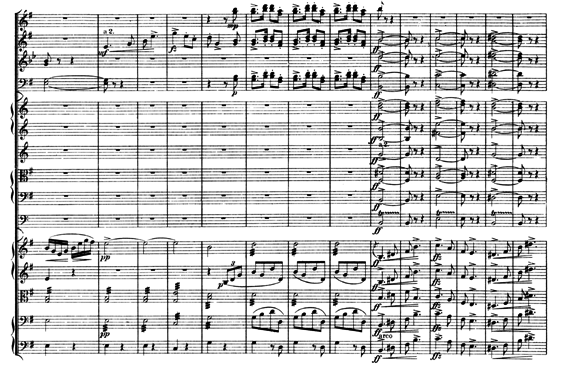Full film scores for study are notoriously and frustratingly difficult to locate, but aspiring film composers needn’t go uninspired: The music of the past can teach us fresh approaches to contemporary musical ideas, while at the same time reminding us of the essential elements that make a piece timeless.
Each of the following five “classical” scores has something to teach modern-day composers of music for media. Under each work’s title, I have indicated the specific compositional techniques the piece best exemplifies. All of these works are available in the public domain (depending on the copyright laws of your country — check before downloading) and can be freely downloaded in both sheet music and audio form for a complete study experience.
1. Symphony No. 9 (New World Symphony) — Dvořák
Area of Study: Thematic Work for Film [Download Here]
For those wishing to compose for film, this piece is essential listening. Listen in particular to the fourth movement, which features unabashedly expressive writing as well as some very well-conceived rhythms.
The composition’s main strength is in its handling of thematic work. A common characteristic of this piece is its frequent recalling of previous themes — a skill which translates well to the world of film scoring. Incidentally (no pun intended!), this composition is at times very reminiscent of a romantic film score.
2. Symphony No. 2, Third Movement – Rachmaninoff
Area of Study: Melodic Work and Lyricism [Download Here]
A personal favorite composer of mine, Rachmaninoff is a romantic composer desperately clinging to the remnants of the Romantic period during the transition toward 20th-century music, and the composition embodies this spirit accurately.
The piece is a fantastic point of study for those wishing to develop their melodic writing skills. Some of the best lyrical writing you’re likely to encounter is found in the clarinet line toward the beginning of the third movement.
Be warned: This yearning, bittersweet melody will stick in your head for days to come.
3. The Planets (Mars, The Bringer of War) — Holst
Area of Study: Creative Use of Rhythm, “Epic” Film Scoring [Download Here]
Even on a cursory listening of this piece, the reasons for its universal influence and acclaim are obvious.
The first minute alone is reminiscent of several contemporary “epic” film scores — Star Wars and Gladiator are notable examples, and you’ll likely be reminded of others as well.
The piece is especially intriguing in its imaginative use of different rhythms, which are divided between families of instruments to create an overwhelming depth of texture.
4. The Firebird — Stravinsky
Area of Study: Creative Orchestration, Animated Film Scoring [Download Here]
The Firebird is a colossal composition in every sense. I was delighted to hear that it was featured in BBC’s “Ten Pieces” initiative, which introduces classical music to children.
If you’ve been searching for a full score that demonstrates plenty of examples of inspiring orchestration, look no further than this piece. Many of its instrumental groupings wouldn’t be out of place in an animated film score.
5. Symphony No. 8 — Mahler
Area of Study: Dynamics and Expressive Builds [Download Here]
I highly recommend listening to this piece in its entirety. Mahler employs not one but two SATB choirs and has them perform an entrance on the most delicate of pp’s — quite a texture to behold. The way it builds into a gargantuan goosebump-inducing majesty is one of the finest moments in classical music history.
Building up your textures gradually is a fantastic skill to master in incidental music (as any Hans Zimmer fan is well aware!). Even if you aren’t working with orchestral instruments, the compositional techniques in this piece translate well to a multitude of musical scenarios.
I hope you enjoy listening to and learning from these pieces. Use the lessons within to enrich your scores for film and other forms of contemporary media. Modern music is informed by the great music of the past, and it’s our duty as creatives to push our art form in new directions. To do that, we must first have a good understanding of what our predecessors did.
If you have any favorite full scores for study that are available in the public domain, we’d love to hear about them — the comments are open!

Thank you.